Classic Airframes 1/48 Curtiss P-6E Hawk | | History The Curtiss P-6E Hawk, 46 of which were delivered to the USAAC in late 1931 and early 1932 ended the series of Curtiss Army biplane Hawks. This series started with the P-1 (redesignated from XPW-8B), 15 of which were ordered in 1925. 1925 was also the start of the intense Boeing/Curtiss Army/Navy fighter competitions of the '20s and '30s. Seattle aviation historian Peter M. Bowers recently covered this competition in good detail in a three-part article (reference H below). The P-6E was both the last and the prettiest of the Army biplane Hawks. As the P-6Es were obsolescent when delivered in '31/'32 the Army did not invest much in heavy maintenance or overhauls on them and, with benign neglect, allowed them to quickly become obsolete and to fade from service. Mr. Bowers notes that one survived in service into 1940. That's a service life of only eight years! It takes longer than that now to get a new model from prototype rollout to production! 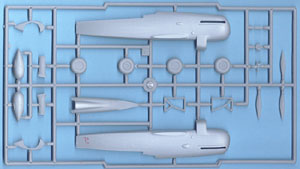 Most people, when they think of the P-6E, mentally picture one of the 17th Pursuit Squadron, First Pursuit Group's "Snow Owl" marked airplanes. The beautifully striking black and white markings were first applied to "tart-up" the unit's khaki-brown and chrome yellow planes for their participation in the 1932 National Air Races in Cleveland. Most modelers will opt for this flamboyant scheme, two versions of which are provided for in the kit, but you don't have to use one of those, almost, trite schemes. If you want to be different you can do a P-6E in the later blue/yellow scheme of 1935-39. So far, in checking my sources, I have found several blue/yellow planes with the open-faced wheel pants, which are also provided in the kit. Most people, when they think of the P-6E, mentally picture one of the 17th Pursuit Squadron, First Pursuit Group's "Snow Owl" marked airplanes. The beautifully striking black and white markings were first applied to "tart-up" the unit's khaki-brown and chrome yellow planes for their participation in the 1932 National Air Races in Cleveland. Most modelers will opt for this flamboyant scheme, two versions of which are provided for in the kit, but you don't have to use one of those, almost, trite schemes. If you want to be different you can do a P-6E in the later blue/yellow scheme of 1935-39. So far, in checking my sources, I have found several blue/yellow planes with the open-faced wheel pants, which are also provided in the kit.
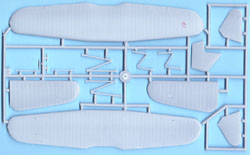 The Kit The Kit
There are 41 well-molded, sharply detailed parts on two sprue trees of light gray styrene and 20 resin detail parts. The resin parts include two especially beautiful 12-port exhausts. In my kit some of the small resin parts were broken. Two vac-formed windscreens complete the kit parts inventory. The six page instructions provide: a brief history, specifications, parts map and 12 illustrated, wordless, assembly steps. There is also a rigging diagram. A separate sheet provides a mask template for the "Snow Owl" black nose. The two sheets of very nice decals provide for two 17th Pursuit Squadron airplanes; one with full wheel pants in the full "Snow Owl" scheme and another for open wheel pants in partial "Snow Owl" markings; both are in the khaki-brown/chrome yellow basic color scheme. 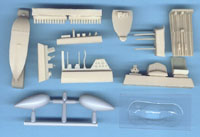 I find no fault with the overall accuracy of the parts presented in this kit by Classic Airframes. There are, however, a few nit-picking quibbles: I find no fault with the overall accuracy of the parts presented in this kit by Classic Airframes. There are, however, a few nit-picking quibbles:
-
The gun troughs in the fuselage sides are too shallow to accept the resin gun barrels. It should be fairly easy to deepen the troughs. -
My kit has a blemish (from a mold crack?) in the left forward fuselage half -
My kit has two sink marks each in the two outside panels for the open wheel pants. Friend Bill Johnson's kit does not have these sink marks, but has one in each of the landing gear struts -
Four lifting lugs and a small servicing hatch are omitted from the top of the top wing -
A small servicing hatch is omitted from the bottom of both bottom wing halves -
The rear running light is omitted from the rudder -
As a matter of personal taste, I will leave off the resin external fuel tank when I build my kit; I think the P-6E is very sleek looking without it. 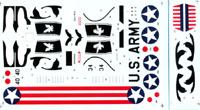 Conclusion Conclusion
As reviewed in-the-box, this is the best and most accurate Classic Airframes biplane kit so far. I hope the fit is as good as the parts. Forget the early 1960s Lindberg P-6E in 1/48th scale; it is no match for this kit. If 1/72nd is your scale you can do no better than the 1968 Monogram release of the P-6E. Except for the lack of interior detail, the Monogram kit is the equal of this Classic Airframes 48th scale kit. I paid $25.46, plus shipping, for my P-6E from Squadron Mail Order. Now, Messrs. Classic Airframes, that you have given us the Hawks and the Ducks how about that Boeing Stearman and that Tiger Moth in 1/48th scale? References -
Curtiss Aircraft 1907-1947: Peter M. Bowers, Putnam, London, 1974, ISBN 0-370-10029-8 -
Profile Number 45: Peter M. Bowers, Profile Pubs., Ltd., London -
Curtiss Army Hawks In Action: Larry Davis, Squadron Signal, Carrollton, TX, 1992, ISBN 0-89747-286-1 -
Airpower magazine, March 1994: Jack Dean article on Ralph Rosanik's repro P-6E -
Historical Aviation Album, Volume V: Paul Matt article and drawings -
IPMS/USA Quarterly, Fall 1986; 17th Pursuit Squadron color schemes -
Air Classics: Issues Unknown, Two-part article by Peter Westburg including his fabulous drawings (These are the best P-6E drawings available.) -
Airpower/Wings magazine, January, February & March 2001: Three-part article by Peter M. Bowers on Boeing/Curtiss competition -
William Wylam's drawings of Curtiss F11C-2 & P-6E -
Aeromodeller Scale Drawings #2698, P-6E & F11C-2 -
The Curtiss Hawks: P. Shamburger & J. Christy, Wolverine Press, Kalamazoo, 1972, Library of Congress Card Number 79-173429 | 


 



  
    |
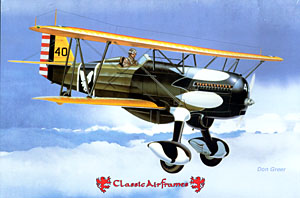
 Most people, when they think of the P-6E, mentally picture one of the 17th Pursuit Squadron, First Pursuit Group's "Snow Owl" marked airplanes. The beautifully striking black and white markings were first applied to "tart-up" the unit's khaki-brown and chrome yellow planes for their participation in the 1932 National Air Races in Cleveland. Most modelers will opt for this flamboyant scheme, two versions of which are provided for in the kit, but you don't have to use one of those, almost, trite schemes. If you want to be different you can do a P-6E in the later blue/yellow scheme of 1935-39. So far, in checking my sources, I have found several blue/yellow planes with the open-faced wheel pants, which are also provided in the kit.
Most people, when they think of the P-6E, mentally picture one of the 17th Pursuit Squadron, First Pursuit Group's "Snow Owl" marked airplanes. The beautifully striking black and white markings were first applied to "tart-up" the unit's khaki-brown and chrome yellow planes for their participation in the 1932 National Air Races in Cleveland. Most modelers will opt for this flamboyant scheme, two versions of which are provided for in the kit, but you don't have to use one of those, almost, trite schemes. If you want to be different you can do a P-6E in the later blue/yellow scheme of 1935-39. So far, in checking my sources, I have found several blue/yellow planes with the open-faced wheel pants, which are also provided in the kit. The Kit
The Kit I find no fault with the overall accuracy of the parts presented in this kit by Classic Airframes. There are, however, a few nit-picking quibbles:
I find no fault with the overall accuracy of the parts presented in this kit by Classic Airframes. There are, however, a few nit-picking quibbles: Conclusion
Conclusion






